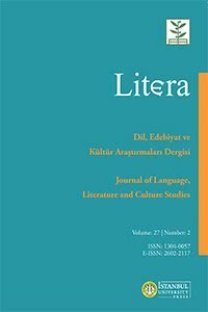Sınırlar Ötesinde Yuva Düşlemek: Sandra Cisneros’un “Çığırtkan Kadınlar” Öyküsündeki Bireyselleşme Yolculuğu
1980’lerden itibaren Latin Amerika kökenli Amerikalı kadın yazarların ortaya koyduğu
(Re)Imagining Home Across Borders: The Construction of Selfhood in Sandra Cisneros’s “Women Hollering Creek”
Since the 1980s, the literary and theoretical output of American women writers ofLatin-American heritage has offered an alternative reading of feminist literary tradition.Sandra Cisneros is probably one of the foremost figures within the American contextof “Border Literature” and “Borders Studies” proper. This article firstly outlines theparameters, theorems and prominent figures of Border Studies, and then examinesCisneros’ short story “Woman Hollering Creek” which deconstructs the dualisticmode of thinking in terms of first world vs. third world dichotomy, and defies variousthematic and structural borders. The story is also a parody of the Mexican populargenres of telenovella (soap opera) and fotonovella (photo novel), and offers a newform of identity formation through the female protagonist’s quest for finding her ownvoice and subjectivity outside the prescribed gender roles attuned to the patriarchaldiscourse proposed in the aforementioned popular genres. Hence, this article offers aclose reading of the story’s narrative strategies on a linguistic and semantic level as theyinform its thematic concerns.
___
Alarcón, N. (1989). Traddutora, traditora: A paradigmatic figure of Chicana feminism. Cultural Critique, 13, 57-87.Alarcón, N. (1990). The theoretical subject(s) of this bridge called my back and Anglo-American feminism. In G. Anzaldúa (Ed.), Making face, making soul / Haciendo Caras: Creative and critical perspectives by feminists of color (pp. 356-69). San Francisco: Aunt Lute.
Anzaldúa, G. (2002). Speaking in tongues: A letter to third world women writers. In C. Moraga & G. Anzaldúa (Eds.), This bridge called my back: Writings by radical women of color (pp. 183-94). Berkeley: Third Woman. (Original work published 1981).
Anzaldúa, G. (1987). Borderlands/La Frontera: The New Mestiza. San Francisco: Aunt Lute Press.
Anzaldúa, G. (1990). Haciendo caras, una entrada: An introduction. In G. Anzaldúa (Ed.), Making face, making soul / Haciendo Caras: Creative and critical perspectives by feminists of color (pp. xv-xxviii). San Francisco: Aunt Lute.
Bhabha, H. (1992). The world and the home. Social Text, 31/32, 141-153.
Bhabha, H. (1994). The location of culture. New York: Routledge.
Candelaria, C. (1986). Chicano poetry: A critical introduction. Westport: Greenwood.
Carillo, L. & Lyson, T. (1983). The fotonovela as a cultural bridge for Hispanic women in the United States. Journal of Popular Culture, 17(3), 59-63.
Castillo, A. (1995). Massacre of the dreamers: Essays on xicanisma. New York: Plume.
Cisneros, S. (1991). The house on Mango Street. New York: Vintage.
Cisneros, S. (2004). Woman hollering creek and other stories (pp. 43-56). London: Bloomsbury, Cisneros, S. (1996). Guadalupe the sex goddess. In A. Castillo (Ed.), Goddess of the Americas: Writings on the Virgin of Guadalupe (pp. 46-51). New York: Riverhead.
Del Castillo, R. G. (1990). The Treaty of Guadalupe Hidalgo: A legacy of conflict. Norman: University of Oklahoma Press.
Erlick, J. C. (2000) Why Latin@s? A note from the editor. DRCLAS News, Spring Issue, 4.
Flora, C. B. (1980). Fotonovelas: Message creation and reception. Journal of Popular Culture, 14(3), 524-534.
Flores, J. & Yúdice, G. (1990). Living borders/buscando America: Languages of Latino self-formation. Social Text, 8(2), 57-84.
Fuentes, C. (1985). The old gringo. New York: Farrar, Straus, and Giroux Inc.
Fuentes, C. Interview with Bill Moyers. In B. S. Flowers (Ed.), A world of ideas: Conversations with thoughtful men and women about American Life Today and the ideas shaping our future (pp. 506-513). New York: Doubleday, 1989.
Hicks, Emily. (1991). Border writing: The multidimensional text. Minneapolis: University of Minnesota Press.
Jameson, F. (1990). Modernism and imperialism. In Nationalism, colonialism, and literature (pp. 43-68). Minneapolis: University of Minnesota Press.
JanMohamed, A. R. & Lloyd, D. (1987). Introduction: Minority discourse – What is to be done? Cultural Critique 7, 5-17.
Lafaye, J. (1976). Quetzalcóatl and Guadalupe: The formation of Mexican national consciousness, 1531-1813. Chicago: Chicago University Press.
Lugones, M. (1987). Playfulness, ‘world’-travelling, and loving perception. Hypatia: A Journal of Feminist Philosophy, 2(2), 3-19.
McCracken, E. (2000). Postmodern ethnicity in Sandra Cisneros’ Caramelo. Journal of American Studies Turkey (JAST), 12, 3-12.
Mohanty, S. (1993). The epistemic status of cultural identity: On beloved and the postcolonial condition. Cultural Critique, 24, 41-80.
Paz, O. (1985). The labyrinth of solitude and other writings. (L. Kemp, Y. Milos & R. P. Belash, Trans.). New York: Grove Press. (Original work published in 1950).
Perez, D. R. (2008). There was a woman: La Llorona from folklore to popular culture. Austin: University of Texas Press.
Pérez, E. (1999). The decolonial imaginary: Writing Chicanas into history. Bloomington: University of Indiana Press.
Said, E. (1988). Representing the colonized: Anthropology’s interlocutors. Critical Inquiry, 15(2), 205-225.
Saldaña-Portillo, J. (2001). Who’s the Indian in Aztlán? Re-writing Mestizaje, Indianism, and Chicanismo from the Lacandón. In I. Rodríguez (Ed.), The Latin American subaltern studies reader (pp. 402-423). Durham: Duke University Press.
Saldívar, R. (1990). Chicano narrative: The dialectics of difference. Madison: University of Wisconsin Press.
Saldívar-Hull, S. (1999). Woman hollering transfronteriza feminisms. Cultural Studies, 13(2), 251-262.
Sandoval, C. (1991). U.S. third world feminism: The theory and method of oppositional consciousness in the postmodern world. Genders, 10, 1-24.
Spivak, G. (1987). Subaltern studies: Deconstructing historiography. In Other worlds: Essays in cultural politics. New York: Methuen, 197-221.
Stevens, E. (1973). Marianismo: The other Face of machismo. In A. Pescatello (Ed.), Female and male in Latin America (pp. 90-101). Pittsburgh: University of Pittsburgh Press.
Viramontes, H. M. (1989). Nopalitos: The making of fiction. In A. H. Delgado, E. Ortega, N. M. Scott & N. S. Sternbach (Eds.), Breaking boundaries: Latina writing and critical readings (pp. 33-38). Amherst: University of Massachusetts Press.
Wolf, E. (1958). The Virgin of Guadalupe: A Mexican national symbol. The Journal of American Folklore 71(279), 34-39.
- Yayın Aralığı: Yılda 2 Sayı
- Yayıncı: İstanbul Üniversitesi
Sayıdaki Diğer Makaleler
Yunan İlkokul Edebiyat Kitaplarında Türk İmajı
Pavlos Matesis ve “Dilsizin Kızı” Eserinde Postmodernist Nitelikler, Milliyetçilik ve Öteki
Türkiye’de İş Yeri Adlandırma Uygulamaları: Yabancı Etkisi
İngilizcede Birhan Keskin: Şiir Çevirisine Metafor Odaklı Bir Yaklaşım
Selanik’in İspanya Yahudileri (Yerleşme, Yükseliş, Büyük Yıkım)
